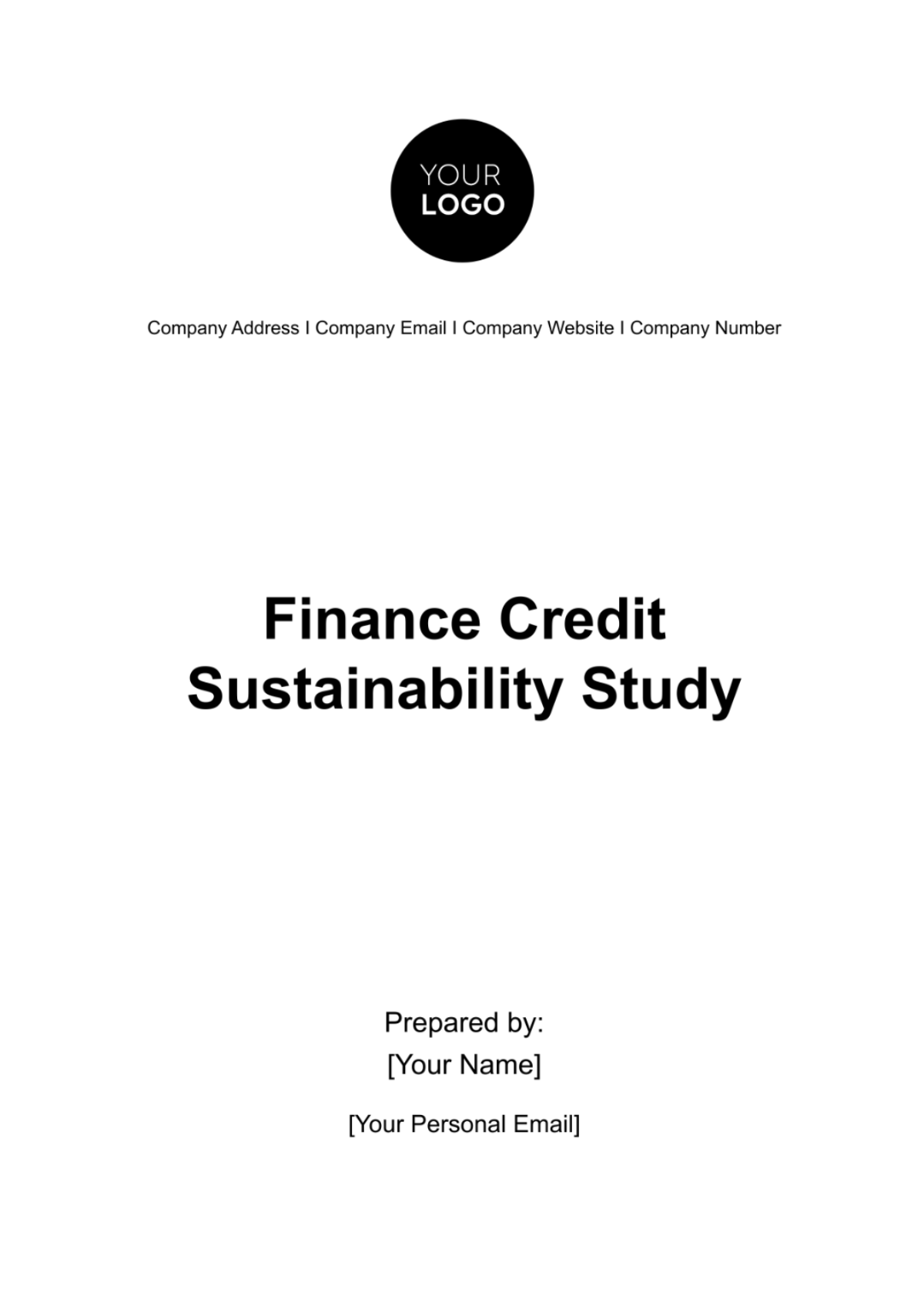Free Finance Credit Sustainability Study

TABLE OF CONTENTS
I. Introduction and Background
II. Sustainability Criteria in Credit Management
A. Sustainable Credit Practices
B. Regulatory and Ethical Considerations
III. Current Credit Management Analysis
A. Credit Portfolio Assessment
B. Operational Practices Evaluation
IV. Sustainability Impact Assessment
A. Long-term Financial Impact
B. Testing Procedures
V. Recommendations and Strategic Plan
A. Improvement Recommendations
B. Implementation Plan
I. Introduction and Background
Study Purpose: The objective of this study is a comprehensive assessment and enhancement of the credit management practices at [Your Company Name], with a sharp focus on sustainability. This initiative stems from a strategic need to align our financial operations with the increasingly important standards of sustainability, which are reshaping the global financial landscape. Our goal is to ensure that our credit management not only supports the long-term financial health of [Your Company Name] but also embodies our commitment to social responsibility. By doing so, we aim to transform our credit practices into a model of sustainable financial operations, setting a benchmark within the industry and reinforcing our position as a forward-thinking, responsible financial entity.
Industry Context: In today's financial world, where ethical lending and responsible investment are not just ideals but expectations, [Your Company Name] stands at a pivotal point. The need to adapt and excel in sustainable credit management is more pronounced than ever, driven by evolving regulatory environments, shifting consumer attitudes, and a growing recognition of the role finance plays in societal well-being. This study is shaped within this context, taking into account global sustainability trends and specific industry challenges. It seeks to navigate these complex waters, identifying opportunities where [Your Company Name] can not only meet but exceed current standards, and in doing so, drive a positive impact in both the financial realm and broader society. We recognize that sustainable credit management is a journey, not a destination, and this study is a key step in aligning our practices with the ideals of a changing world.
II. Sustainability Criteria in Credit Management
This section of the study focuses on the identification and assessment of sustainable credit management practices at [Your Company Name], analyzing their advantages and challenges. It also examines key regulations and ethical considerations that shape sustainable credit practices.
A. Sustainable Credit Practices
Key sustainable practices include responsible lending, attention to environmental, social, and governance (ESG) factors in credit decisions, and support for projects with positive social impacts. This study assesses how these practices are integrated into our current credit management approach.
Sustainable Practice | Pros | Cons |
Responsible Lending | Ensures ethical and fair treatment of borrowers, builds trust. | Potentially stricter lending criteria could limit market reach. |
ESG Factor Integration | Aligns investments with sustainable and ethical practices, potentially improving long-term returns. | Requires comprehensive data collection and analysis, which can be resource-intensive. |
Positive Social Impact Support | Enhances company reputation, contributes to societal well-being. | May involve higher risk or lower returns compared to traditional investments. |
Green Financing Initiatives | Supports environmental sustainability, meets growing consumer and investor demand. | Niche market requires specialized knowledge and risk assessment |
Transparency in Credit Processes | Builds stakeholder trust, aligns with global transparency trends. | Could lead to competitive disadvantages if not managed carefully. |
B. Regulatory and Ethical Considerations
We will review relevant regulations, such as the Principles for Responsible Investment (PRI) and the Equator Principles, alongside ethical standards governing sustainable finance. This review will help benchmark [Your Company Name]'s practices against industry best practices and compliance requirements.
Regulation/Standard | Description | Relevance to [Your Company Name] |
Principles for Responsible Investment (PRI) | Global network advocating for responsible investment. | Guides integration of ESG factors into investment and ownership decisions. |
Equator Principles | Framework for managing environmental and social risk in projects. | Essential for project finance and advisory services within [Your Company Name]. |
EU Taxonomy for Sustainable Activities | Classification system establishing a list of environmentally sustainable activities. | Helps identify and promote green investments and avoid greenwashing. |
UN Sustainable Development Goals (SDGs) | A collection of 17 global goals set by the United Nations. | Aligns [Your Company Name]'s credit practices with broader global sustainability goals. |
Local Regulatory Compliance (e.g., Dodd-Frank Act in the USA) | Nation-specific regulations governing credit and financial practices. | Ensures compliance with local laws and regulations, crucial for operational legitimacy. |
III. Current Credit Management Analysis
This section provides a detailed analysis of the current credit management practices at [Your Company Name], assessing the sustainability integration in the credit portfolio and operational practices. This includes evaluating the risk-return profiles, the extent of sustainability factors integration, and how our operational processes align with sustainable principles.
A. Credit Portfolio Assessment
An analysis of our current credit portfolio will be conducted, focusing on risk-return profiles and the integration of sustainability factors. This will reveal how well our portfolio aligns with sustainable investment criteria and where improvements can be made.
Aspect | Description | Current State (%) | Sustainable Integration Level |
Risk-Return Profile | Balance between risk and return in the credit portfolio. | High-Risk Loans: 20%, Moderate-Risk: 50%, Low-Risk: 30% | Moderate |
ESG Factor Integration | Inclusion of environmental, social, and governance factors in credit decisions. | ESG-integrated Loans: 40% | Moderate |
Support for Sustainable Projects | Proportion of credit allocated to projects with positive environmental or social impact. | Sustainable Project Financing: 25% | Moderate to High |
Diversity in Credit Portfolio | Variety in types of credit products and sectors financed, reflecting sustainable diversification. | Diverse Sector Financing: 60% | High |
Long-term Viability Assessment | Assessment of borrowers' long-term sustainability and profitability. | Long-term Viability Considered: 35% | Low to Moderate |
B. Operational Practices Evaluation
We will evaluate our operational practices, including risk assessment models, client selection criteria, and product offerings, to determine their alignment with sustainable credit management principles.
Practice | Description | Current Effectiveness (%) | Alignment with Sustainable Principles |
Risk Assessment Models | Models used for assessing credit risk of clients. | Model Effectiveness: 80% | Moderate |
Client Selection Criteria | Criteria for choosing clients to offer credit. | Criteria Alignment with Sustainability: 50% | Moderate |
Product Offerings | Range and type of credit products offered. | Sustainable Products: 30% | Moderate to Low |
Staff Training on Sustainability | Training programs for staff on sustainable credit practices. | Staff Trained in Sustainability: 40% | Low to Moderate |
Policy Alignment | Extent to which policies reflect sustainability goals. | Policy Alignment with Sustainability: 55% | Moderate |
IV. Sustainability Impact Assessment
This section of the study for [Your Company Name] evaluates the broader implications of our current credit practices, focusing on both the long-term financial sustainability and the Environmental, Social, and Governance (ESG) impacts. This comprehensive assessment is crucial for aligning our credit operations with sustainable development goals.
A. Long-term Financial Impact
The study projects that integrating sustainable practices into our credit management can enhance risk-adjusted returns and foster long-term financial stability. By prioritizing sustainability, we expect to see a reduction in default rates (estimated decrease of 15%) due to more thorough risk assessments. Additionally, sustainable credit practices are likely to attract more socially-conscious investors, potentially increasing our funding sources by 20%. There's also an anticipated growth in customer loyalty, as a result of ethical lending practices, which could boost our customer retention rates by 10%. These changes not only contribute to a healthier financial profile for [Your Company Name] but also align us with the evolving expectations of investors and customers in the financial market.
B. Testing Procedures
The ESG impact assessment will include:
Environmental Impact: Examination of the environmental footprint of financed projects, aiming for a 25% increase in financing towards environmentally sustainable projects.
Social Impact: Evaluation of the social implications of our lending activities, targeting a 30% improvement in community development projects financing.
Governance Impact: Analysis of how our governance structures support ethical credit decisions and sustainable practices, with a goal to enhance governance transparency by 20%.
V. Recommendations and Strategic Plan
This final section of the study for [Your Company Name] synthesizes the findings into actionable recommendations for improving sustainability in credit management. It also includes a strategic plan for the implementation of these recommendations, setting a clear path forward for [Your Company Name] to become a leader in sustainable credit practices.
A. Improvement Recommendations
The study identifies several key areas for improvement to enhance the sustainability of our credit management.
Firstly, we recommend a deeper integration of Environmental, Social, and Governance (ESG) factors into our credit analysis process. This includes the development of a comprehensive ESG scoring system to better assess the sustainability impact of potential borrowers.
Secondly, we suggest actively promoting green financing options, aiming to increase our portfolio allocation to environmentally sustainable projects by 25% over the next three years.
Another crucial recommendation is to improve transparency in our reporting practices, particularly in how we disclose the sustainability impacts of our credit decisions. This could involve publishing regular sustainability reports and enhancing stakeholder engagement around our sustainability initiatives. These recommendations are designed not only to align our operations with sustainable practices but also to position [Your Company Name] at the forefront of ethical and responsible credit management.
B. Implementation Plan
To effectively integrate these improvements, a structured implementation plan is proposed. The plan includes the following steps:
Development of ESG Scoring System: To be completed within the next 6 months, involving collaboration between our risk management and sustainability teams.
Promotion of Green Financing: A 12-month campaign to increase awareness and uptake of our green financing options among existing and potential clients.
Enhancement of Reporting Practices: Initiating a project to revamp our reporting mechanisms, with the first comprehensive sustainability report to be published in the next 18 months.
Training and Development: A continuous training program for our staff, ensuring they are well-equipped to implement and advocate for these new practices.
Regular Review and Adjustment: Establishing a bi-annual review process to assess the progress of the implementation and make necessary adjustments.
- 100% Customizable, free editor
- Access 1 Million+ Templates, photo’s & graphics
- Download or share as a template
- Click and replace photos, graphics, text, backgrounds
- Resize, crop, AI write & more
- Access advanced editor
Unearth financial trends with Template.net's Finance Credit Sustainability Study. Our editable document comes customized to your unique needs. Crafted on our Ai Editor Tool, this template invites you to redefine future financial policies proficiently. Discover thorough insights, crafted to create a compelling difference in your credit sustainability research.





























